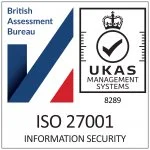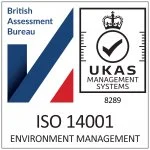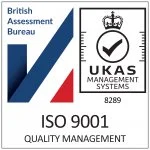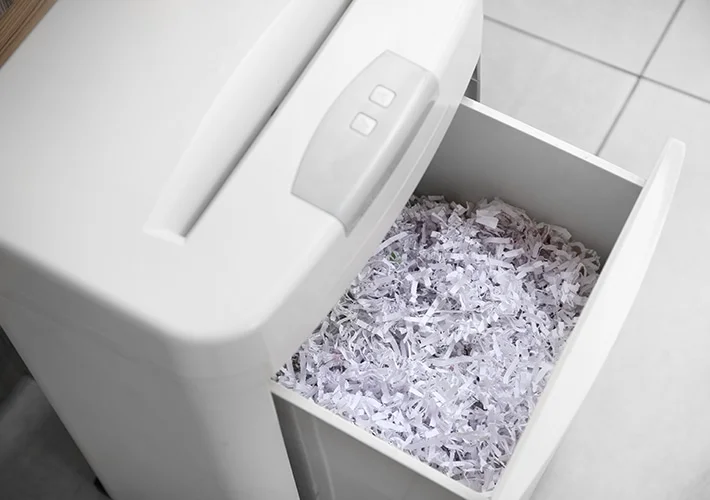Businesses today are keen to find ways to reduce their impact on the environment. Recycling shredded paper is an easy yet powerful method to achieve this. According to the Environmental Protection Agency (EPA), recycling one ton of paper saves 17 trees and a lot of water, while also cutting down on harmful greenhouse gases.
Shredded paper recycling not only helps the planet, but it also offers financial and security benefits for your business. Whether you’re just starting or looking to improve your confidential waste collection, this guide covers everything you need to know about recycling shredded paper in your business.

Get a quote
What is Shredded Paper Recycling?
Shredded paper recycling is the process of turning paper that has been cut into small pieces back into new, usable paper. This stops paper from ending up in landfills, where it takes years to break down and releases harmful gases like methane. The Journal of Industrial Ecology states that recycling paper can save up to 60% of the energy and water needed to make new paper.
In businesses, shredded paper often comes from destroying documents that contain sensitive information. Laws like the General Data Protection Regulation (GDPR) in the UK or the Data Protection Act 2018 require this to protect privacy. Recycling shredded paper allows businesses to stay secure while also helping the environment, meeting standards like ISO 14001, which focuses on environmental management.
Inspire Waste Management is ISO certified and accredited within BAB (British Assessment Bureau) to UKAS standards and CHAS (Contractors Health & Safety Assessment Scheme).




How to Implement Shredded Paper Recycling in Your Business
Setting up a shredded paper recycling programme in your business is easy and beneficial. Follow these steps to get started:
Step 1: Assess Your Paper Usage
Step 2: Choose a Recycling Partner and Recycling Bin
Choose the right business waste management partner to handle your shredded paper. Look for a service that specialises in shredded paper and is certified by organisations like ISO 27001, which focus on information security. Your provider should follow all legal and environmental rules to keep your business safe and compliant.
Step 3: Educate Your Team
Step 4: Implement Secure Collection Points to Prevent Identity Theft
Step 5: Monitor and Improve
Once your programme is running, keep an eye on how well it’s working. Check your recycling data regularly to see how much paper is being repurposed and look for ways to improve. This might include adjusting your collection schedule or providing more training for staff. Creating a feedback loop will also help keep the programme strong and effective.
Make a Difference: Implement Shredded Paper Recycling in Your Office
Get a quote
Benefits of Shredded Paper Recycling
Shredded paper recycling provides several key benefits for both businesses and the environment. By ensuring that shredded paper from paper documents is properly collected and placed in a recycling bin, you help prevent identity theft and reduce fire hazards associated with improperly discarded paper items.
Local councils often encourage businesses and homeowners to collect shredded paper in short lengths and dispose of it in a paper bag or even a cereal box, which can then be added to home compost bins or used as animal bedding.
Shredded paper can pose a fire hazard in sorting plants, as the small and light paper strips are easily blown around and can become trapped in machinery, creating potential safety risks. This practice not only diverts waste from landfills but also allows shredded paper to be repurposed as packaging material or home compost bin, contributing to sustainability.
Soft shredded paper is versatile and can be reused as animal bedding, protective packaging within parcels, or even as an alternative to confetti.
Recycling these very short lengths of paper is an eco-friendly choice that supports environmental conservation and enhances security.
Best Practices for Shredded Paper Recycling
To make your shredded paper recycling programme as effective as possible, follow these best practices:
- Keep Shredded Paper Clean and Dry
- Use Cross-Cut Shredders
- Avoid Over-Shredding
- Reuse Where Possible
- Stay Updated on Recycling Regulations

By setting up a solid recycling programme and following best practices, your business can make a real difference. It’s easy to start, and the benefits are clear. Why not begin today? Every effort counts towards protecting our planet for the future.
Take the First Step Towards Sustainability with Shredded Paper Recycling
Get a quote
Shredded Paper Recycling FAQs
1. Can all types of paper be shredded and recycled?
Not all paper can be shredded and recycled. For example, glossy paper or paper with heavy inks or plastic coatings might not be recyclable. Always check with a professional recycling provider or refer to guidelines from the government to find out what can be recycled.
2. How secure is shredded paper recycling?
Shredded paper recycling is secure, especially with a certified provider. Make sure your recycling partner follows standards like ISO 27001 to guarantee your documents are handled securely.
3. How often should I schedule shredded paper recycling pickups?
The frequency of pickups depends on how much shredded paper your business generates. Small businesses might need pickups weekly or bi-weekly, while larger businesses may need more frequent collections. Talk to your recycling provider to set a schedule that works best for you.
Get a quote





